Midway point celebration: time for some delicious midway brownies! Our bellies and souls are happy.
But the next day with quite a distance still left to go, we hit a period of unrest. The weather had turned grey and dreary and for a moment it seemed spirits had dropped and the excitement of getting to shore hadn’t set in yet.
The days were all blurred and the log is the only thing that gives us a sense of the date and what day of the week it is. As mentioned in the previous blog post we had left the Pacific high. A big low pressure system was passing across the North Pacific, so we buttoned down the hatches expecting an exciting few days. True to the nature of lows we first had a warm front come through lulling us into a false sense of not having to actually wear that many cloths after all. Though a warm front is mizzley and rainy so we still had to put on all the layers of foul weather gear regardless. And alas the warmth did not last and a squally cold front came our way. But even in these rainy squalls the wind didn’t pack too much punch and the highest winds we saw were in the range of the low thirties (in knots = nautical miles per hour).
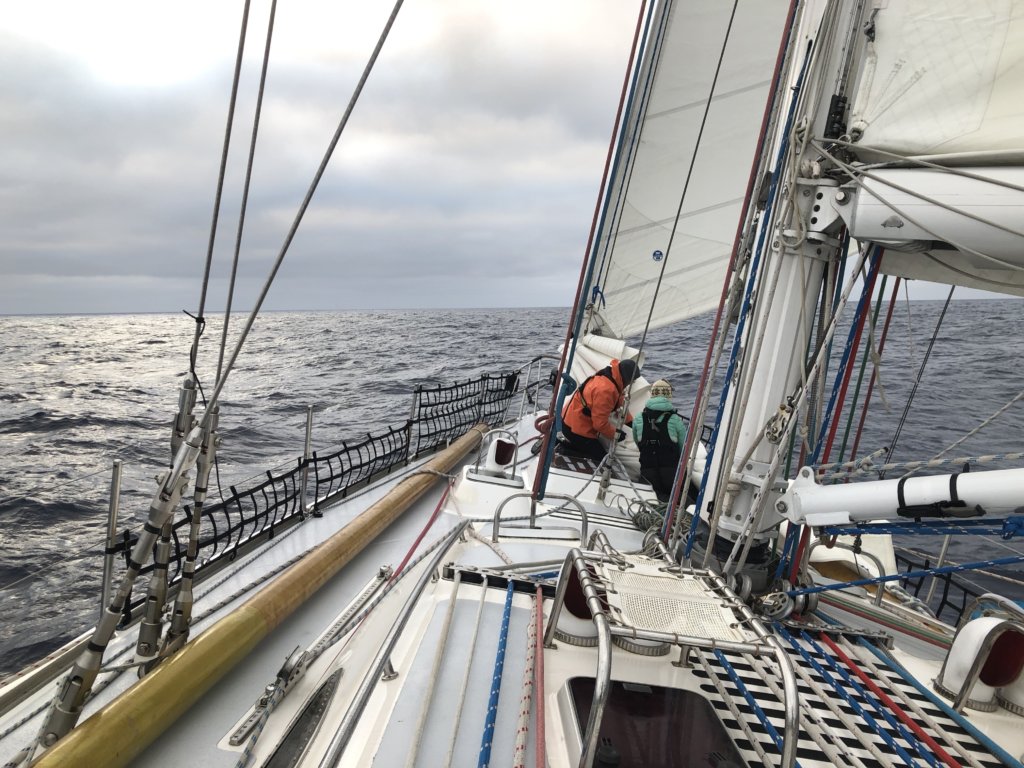
During the night, my watch got thoroughly creeped out and disorientated by the darkness of the sky. The differentiation between the ocean and the horizon was practically indiscernible. The helming efforts of all were valiant but with little to no visual reference points to steer by we (especially on my watch) did some expert zig-zagging. If you’re not used to helming it’s very hard to know how quickly the helm (so the rudder) needs to be straightened out again. With no visual aid of a horizon, clouds or stars you can’t even see the bow turning, you have to feel it or have enough experience to know how quickly the boat turns. If you do overshoot in one direction, overcorrecting in the other direction is a normal mistake and so the slaloming begins. On an ocean passage it isn’t always as crucial as say in a channel with shipping traffic and rocks to go completely straight. But everyone, even those that had their first helming attempts on Sea Dragon with us, had by this point improved by leaps and bounds compared to helming efforts on day one!
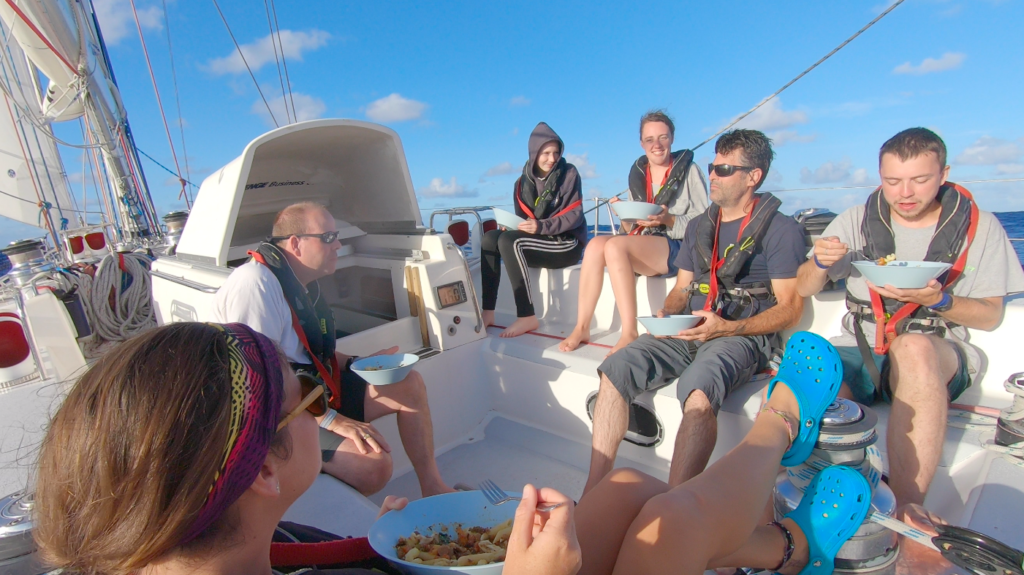
What I like about these trips is how many unlikely friendships form on these kinds of longer trips. This hit home once again as I was watching everyone from the helm eating dinner in the cockpit. Such different characters and life stories come together that probably wouldn’t have met or certainly not spent so much time together on shore! Everyday, up to 10 hours will be spent together on deck bearing wind and weather, chattering through all sorts of silly and serious topics. The little privacy in general allows you to get very comfortable around each other very quickly. A two week passage is a lot of time to talk.
August 1st was the Swiss national holiday and I decided to bake our typical Sunday bread called Zopf. So everyone got a little plaited bread for lunch. For being at baked sea it turned out surprisingly well.
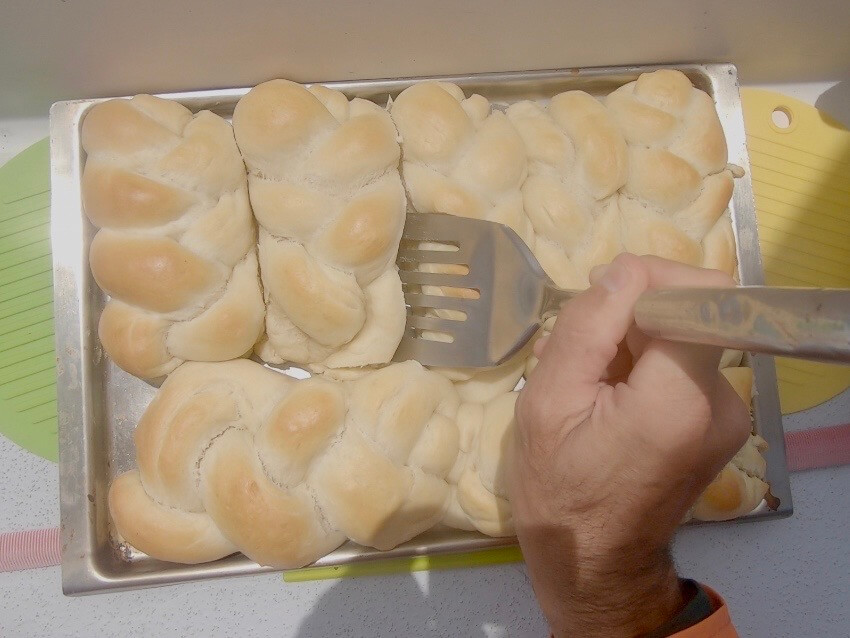
The next day was Shanley’s birthday and from the early hours of the morning happy birthday singing in any language from English to French to Mandarin could be heard above and below deck. Eric had a particular triumph in finding a way to bake Shanley birthday cupcakes that weren’t wonky! The oven on Sea Dragon isn’t on a gimbal like our stove. Basically, the gimbal allows the stove to swing freely and stay horizontal no matter the heel of the boat or the height of waves, insuring our food doesn’t go flying across the galley and saloon every meal we cook. However, since the stove is fixed, it means on a heel anything baked will end up being very lopsided to the lower side of the oven. Anyway, Eric managed to tilt the tray in a manner that he could present the chuffed birthday girl with normal shaped cupcakes. They even had bright blue icing which with colorful fish-shaped sprinkles! (Though the icing left our teeth and an odd shade of blue-green, which looked very amusing when anyone smiled.)

A some point we saw a whale again. It was big, very big and with a very prominent splashguard around its blowhole. Since we couldn’t see a dorsal fin on it’s very long back, we are assuming it was a blue whale. The size certainly would fit, they really are huge.
As people following our track will know, we tacked (in this case ‘turned right’) on Saturday (03/08).
The next few were mostly dry. Grey nevertheless, but dry which Sean was particularly happy about since it always seemed to rain mainly on his and Andrews watch.
The wind had settled aft and we couldn’t believe how lucky we were that no more low pressure systems were coming our way. The wind was anywhere between 8 and 24 knots but coming from behind it felt a lot mellower than if we’d been sailing upwind. Equally, the swell was incredibly small meaning little resistance and smooth progress.
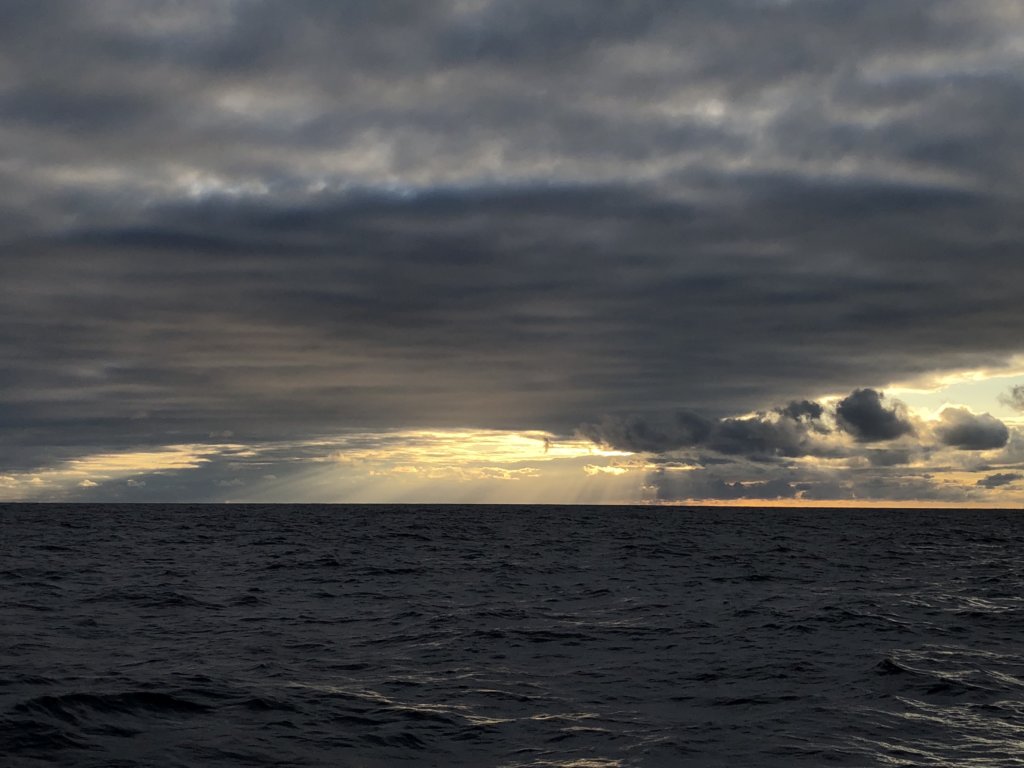
On the 4th of August we entered the Canadian EEZ. 200nm left to shore. We asked Megan (our onboard Canadian) if she felt at home again. But apparently crossing an invisible line marking the entry to Canadian waters doesn’t feel particularly welcoming. We, however, got into a new routine of discussing what food we wanted to eat as soon as we got to shore or how many hours to the next waypoint (a somewhat arbitrary set of coordinates on the chart plotter delineating a vague but safe course for us to follow).
We also with the help of our local Victoria guide Megan, made a whole list of activities to do once we got to Victoria. One item on that list was axe throwing, apparently that is a thing here in Canada. It’s like darts but with a bigger target and you throw an axe instead of a dart. We’ll see how that goes…
“Dolphins!” The call came from Shanley at the helm. After the whale the other day we’d all been keeping our eyes peeled for any cetaceans in the vicinity. But no one reacted to her cry. So many times they had been too far away or gone after a few jumps in the distance. “They are close!” That got us all into action scrambling to get our life jackets on and climb on deck. Sure enough a pod of Pacific White-Sided dolphins was gliding through the waves right next to us. A couple were even bow riding as we tripped ourselves along the deck trying to get up front and clipped on to the lifelines. But once again it was a brief visit and over just as we all got to the bow. Pacific White-Sided Dolphins have a very distinct pattern, as the name suggests, making them easily identifiable. The first part of them you see is the dorsal fin which is split half and half, black in front white at the back. Contrary to common dolphins or bottle nose dolphins they don’t have much of a ‘beak’ and their heads look more rounded and porpoise-like.
The second to last day of the trip we set our spinnaker pole and went wing on wing. In this case that meant our jib was set on the port side of the boat, while our main was let far out on the starboard side. The pole keeps the jib nice and far out so we can maximize the sail area being hit by the wind which was coming from behind.
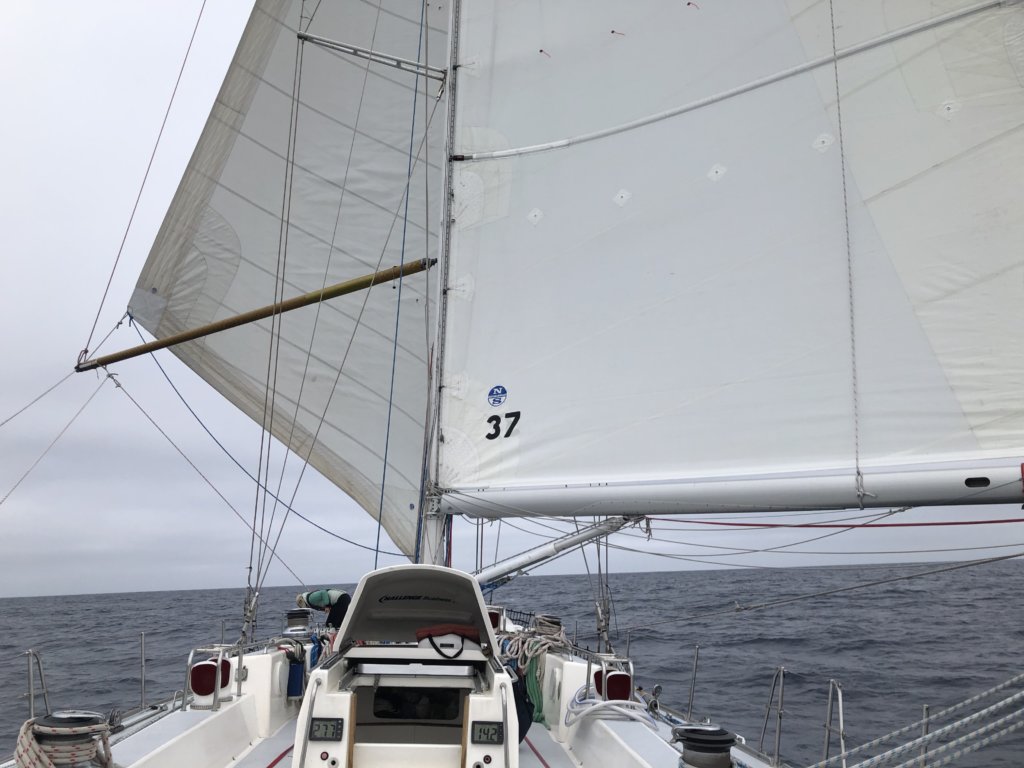
A pleasant surprise of spectacular bioluminescencegreeted all during the watch changeover between Andrew/Sean and Chris/Chip. The white caps of every wave was a fluorescent green. For those who don’t know what bioluminescence are, it’s the little planktonic organisms way todeter predators lure prey. So they light up when they are disturbed (i.e moved). So when they are present, every movement in the water like for example a wave breaking or a bird, dolphin or fish swimming will leave a glowing trail. The wake off the back of Sea Dragon often looks like we’re floating through a night sky with green northern lights.
We lost Sean in the heads for a good 20 minutes as he had heard you could see the luminescent plankton glowing in our sea water flushing toilets if you switched the lights off. So he pumped and pumped the heads with the lights off until the others called him back on deck to come see the spectacular scene. It may sound like a silly thing to do but it’s really fun and all of us ended up trying it too.

Bets were made on how soon into the Strait of Juan de Fuca, we would get fog. The Strait of Juan de Fuca is the channel of water forming the boarder between Canada (Vancouver Island) and the USA (Olympic Peninsula). Fog is a common weather phenomenon here, especially in summer, due to the difference in temperature between the air (warm) and the water (cold). Shanley and Eric having sailed in the area before were a lot less optimistic than the rest of us. Sure enough, just as we approached the mouth of the strait where shipping traffic increased and carefully calculating collision courses became the norm again (out at sea we only actually saw 2-3 ships), the fog drew in around us. Only it was the middle of the night. The problem with the fog at night is that even if it feels like you don’t see much less than normal, in reality you can’t see passing ship’s lights even when they are quite close. So we had to rely heavily on radar and AIS to know where the ships were. The good thing here is that there is a designated shipping channel for all the big cruise and cargo ships, which we happily stayed out of!
The fog stuck with us throughout the morning. To look out for any potential objects that could appear suddenly out of the thick grey curtain, we had a person stationed at the bow. Chip expertly maneuvered us around a unexpected huge floating log (~ 10 meters) that was set on collision course with us. Logs are something to look our for in these waters and we spotted a few more but none of that calibre.
After a few hours the fog south of us cleared and we had the most spectacular view of the mountains in Olympic National Park towering majestically over the fog bank sat on the water. We were so close to the Canadian shoreline, we could hear the fog horn coming from the markers on the rocks to port of us. But alas good old Canada stubbornly stayed hidden behind its cloak of fog.

Finally, finally as we altered our course to port and northwards into Victoria the fog dissipated to reveal a gloriously sunny and blue skied day in Victoria. Shedding layers we re-entered civilization and the buzz of waterway traffic: water taxis, sea planes, ferries and pleasure boats. Our first stop, the customs dock. Fortunately, Canada was happy to welcome us and within the hour we were squeezing around the end of a pontoon into our berth at the Wharf Street Marina. After 15 days at sea and having logged a distance of 2612nm, we docked and set foot on Canadian soil. Well done crew, and hello Canada!





















